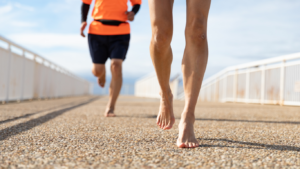Can I Run A Marathon Barefoot?
By APA Sports & Exercise Physio, Britt Caling
 The simple answer to this question is “yes”. As a Sports Physio, I would suggest that almost anyone can run a marathon barefoot if you have the patience to allow your body to adapt to barefoot running conditions and the persistence to work on the technical/skill aspects of running.
The simple answer to this question is “yes”. As a Sports Physio, I would suggest that almost anyone can run a marathon barefoot if you have the patience to allow your body to adapt to barefoot running conditions and the persistence to work on the technical/skill aspects of running.
The barefoot running trend has evolved from studying our evolutionary biology. Harvard Professor Daniel Lieberman is leading the way on explaining this topic. As a brief summary, it is suggested that 2million years ago when Humans transitioned to eating meat, we developed a rare skill within the animal world: that is, the ability to run long distances at speeds faster than most quadrupeds can gallop. Professor Lieberman explains that most animals can’t regulate their heat while galloping, so this Human ability allowed us to track quadruped animals over long distances until the animal died of heat exhaustion: a technique known as “Persistence Hunting”.
A word of caution before deciding to throw away your shoes and start run training for a marathon based on our evolution: barefoot running does not guarantee you will be injury-free. I believe what is more important for reducing the risk of injury is the running technique you use rather than what is on your feet. However, it does seem that the biggest benefit of barefoot running is that it automatically improves your running technique. So for those athletes that have less interest (or motivation) in wanting to improve running technique by doing drill work and thinking about their running, barefoot running may be for you!
The main technique benefits that come from barefoot running:
1. Habitual barefoot runners almost always forefoot strike. This allows the forefoot to spread the force of foot strike over a longer time and reduces the forces travelling up into the lower limb and spine
2. Barefoot runners naturally have a higher stride frequency and shorter (more appropriate) stride length. Basically it hurts your feet to over stride so you will learn how to take an appropriate step length.
3. Barefoot runners have no rapid impact force spike on foot strike (Impulse at foot strike reduces from 6-7% of body mass to 1.4%). A high impact force spike has been associated with increased risk of lower limb injuries. A good example of understanding this is if you try running barefoot on a hard surface you will notice how quiet your foot strike is. A loud foot strike is an indication of a higher collision force with the ground. Lower ground collision forces means less force being transmitted to, and absorbed by, the tissues in your body.
4. Improved proprioception of you foot and lower limb position in space. Our feet have a huge number of proprioceptors (position sense receptors) within them so running barefoot provides more sensory feedback to our body in space.
With all these benefits of going barefoot, why can’t you just start doing all you’re running without shoes? The biggest risk is injury to your Calf, Achilles or Intrinsic Foot. Barefoot running results in increased activation in your calf and the small muscles that make-up the arches of your feet. If these muscles are not strong to begin with, then suddenly doing all your running barefoot may result in overuse injury to these tissues. Just like any other muscle in your body, these can be strengthened but this process takes time. A realistic time-frame to transition from running in shoes to running a full training program barefoot without injury is likely 18months to 2years. Patience and persistence are definatley required.
Below are the tips to helping you run a Marathon barefoot:
– Remember: barefoot and shod running are different. Transition slowly to build calf, achilles and foot muscle strength. These tissues need time to adapt to greater loads. The time-frame for this adaptation before you can run a Marathon will be individual, but I would advise starting your barefoot running very minimally (ie. 2-5min at a time) and taking 2-3years to transition to a full running program in bare feet.
– Gradually increase your time running barefoot. Either carry your shoes with you or run close to home so you can put your shoes on mid run and continue to work on the same run technique with shoes on.
– Relax when starting to run barefoot and run on slightly harder (but smooth) surfaces so you can listen to your foot strike. It should sound soft. This means not listening to music when you first start out barefoot run training.
A final note:
Running form is more important than what is on your feet. So whether you choose to wear shoes or not, you can improve your running by simply by working on your technique

































